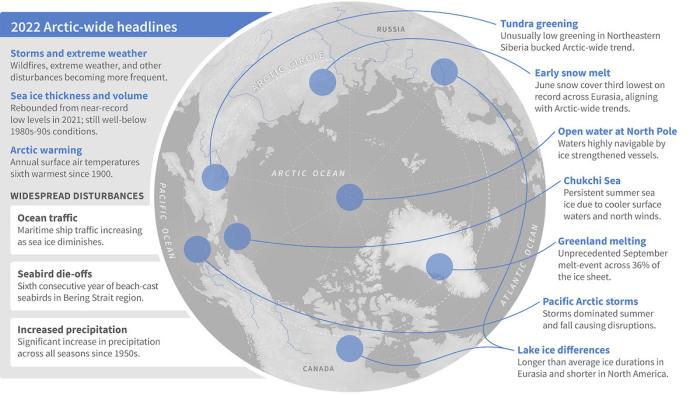By: Matthew L. Druckenmiller, National Snow and Ice Data Center and Cooperative Institute for Research in Environmental Sciences, University of Colorado Boulder; Rick Thoman, Alaska Center for Climate Assessment and International Arctic Research Center, University of Alaska Fairbanks; and Twila A. Moon, National Snow and Ice Data Center and Cooperative Institute for Research in Environmental Sciences, University of Colorado Boulder
The 17th annual NOAA Arctic Report Card was released on 13 December 2022 at the American Geophysical Union 2022 Fall Meeting. With contributions from 147 authors across 11 different countries, the 2022 Arctic Report Card provides an updated annual view into the state of the Arctic by checking in on key vital signs — eight defining elements of the Arctic's climate and environmental system. For the first time in a decade, an addition was made to the vital signs roster this year with an essay on precipitation. This report also samples critical and emerging topics across the Arctic, bringing into focus diverse collections of observations that help to assess the overall trajectory of Arctic change.
Few parts of the world demonstrate such rapid seasonal shifts in temperature, land and ocean cover, ecological processes, and wildlife movement and behavior as the Arctic. These extreme shifts across the annual cycle are a source of the Arctic region's heightened sensitivity to climate changes and climate-related disturbances. The Arctic is also a region of sparse reliable in-situ observations, especially relative to its importance in understanding the Earth's changing climate and associated societal consequences. Shifting seasons and climate-driven disturbances, such as wildfires, extreme weather, and unusual wildlife mortality events, are becoming increasingly difficult to assess within the context of what has been previously considered normal.
The report's Vital Signs section includes essays on eight elements of the Arctic climate and environmental system: Surface Air Temperature, Terrestrial Snow Cover, Precipitation, Greenland Ice Sheet, Sea Ice, Sea Surface Temperature, Arctic Ocean Primary Productivity: The Response of Marine Algae to Climate Warming and Sea Ice Decline, and Tundra Greenness.
Other essays in the report include: Satellite Record of Pan-Arctic Maritime Ship Traffic, Lake Ice, and Arctic Geese of North America, Arctic Pollinators, Lessons From Oceans Melting Greenland, a NASA Airborne Mission, Partnering in Search of Answers: Seabird Die-offs in the Bering and Chukchi Seas, and Consequences of Rapid Environmental Arctic Change for People.
The Consequences of Rapid Environmental Arctic Change for People essay, from the Study of Environmental Arctic Change (SEARCH), illuminates how people experience change as the combined effects of altered physical conditions, infrastructure vulnerability, access to resources, and local-to-global economic drivers. This lesson is not only true of human well-being; environments, animals, and the Arctic system itself are experiencing multiple stressors, and it is the combined, cumulative effect that sustained Arctic observing aims to understand. Northern migratory animals, in particular, are unique as they experience environmental, climatic, and anthropogenic stresses accumulated across many different regions, often well beyond the Arctic. Drawing on observations from a network of Tribal, State, and Federal partners in Alaska, seabird die-offs across the northern Bering Sea and southern Chukchi Sea were reported for the sixth straight year in 2022, maintaining concerns that massive ecological shifts in a warming and less ice-covered ocean are stressing these top predators in the food chain.
Overall, the 2022 Arctic Report Card highlights an Arctic in transition. Large scale, long-term trends are reinforced by another year of observations, while regional differences across the Arctic are increasingly apparent. The Arctic remains a varied and expansive region to monitor. To understand its transition, local to international partnerships—especially with Arctic Peoples and Indigenous communities—are vital to the use of diverse observations and knowledge, as well as to identifying solutions to long-term climate impacts and abrupt disturbances.
This article was adapted from the Executive Summary of the 2022 Arctic Report Card. Further information is available on the NOAA Arctic Program website and in the ">Arctic Report Card 2022 full-length video (YouTube).
About the Authors
 Matthew Druckenmiller is a research scientist at the National Snow and Ice Data Center. Since 2006, he has worked within the coastal regions of Arctic Alaska, investigating the connections between changing sea-ice conditions and marine mammal habitat, and local Indigenous community use of sea ice for hunting and travel. Currently, he serves as Director of the Navigating the New Arctic Community Office (NNA-CO) and co-leads the Exchange for Local Observations and Knowledge of the Arctic (ELOKA).
Matthew Druckenmiller is a research scientist at the National Snow and Ice Data Center. Since 2006, he has worked within the coastal regions of Arctic Alaska, investigating the connections between changing sea-ice conditions and marine mammal habitat, and local Indigenous community use of sea ice for hunting and travel. Currently, he serves as Director of the Navigating the New Arctic Community Office (NNA-CO) and co-leads the Exchange for Local Observations and Knowledge of the Arctic (ELOKA).
 Rick Thoman is an expert in Alaska climate and weather with the Alaska Center for Climate Assessment and Policy (ACCAP). He produces reliable Alaska climate change information and graphics describing Alaska's changing environment. His work spans the bridge between climate modeling, Alaska communities, and media.
Rick Thoman is an expert in Alaska climate and weather with the Alaska Center for Climate Assessment and Policy (ACCAP). He produces reliable Alaska climate change information and graphics describing Alaska's changing environment. His work spans the bridge between climate modeling, Alaska communities, and media.
 Twila Moon is the deputy lead scientist at the National Snow and Ice Data Center and the science communication liaison. Moon is an expert in contemporary glacier and ice sheet changes, and the connections among ice, climate, ocean, and ecosystem. While she has conducted work across the globe, her primary focus is on the Greenland Ice Sheet and the Arctic. Her projects span discovery science, research tool building, and science community organization.
Twila Moon is the deputy lead scientist at the National Snow and Ice Data Center and the science communication liaison. Moon is an expert in contemporary glacier and ice sheet changes, and the connections among ice, climate, ocean, and ecosystem. While she has conducted work across the globe, her primary focus is on the Greenland Ice Sheet and the Arctic. Her projects span discovery science, research tool building, and science community organization.

